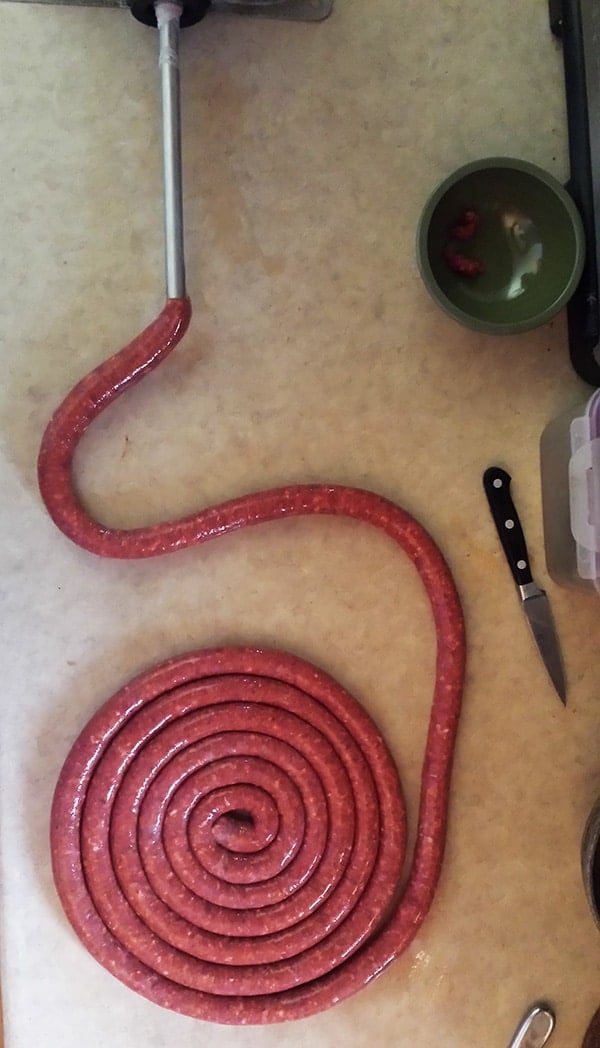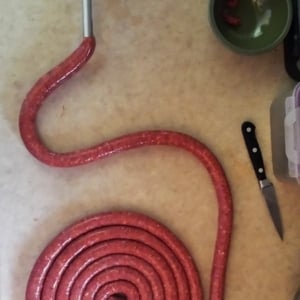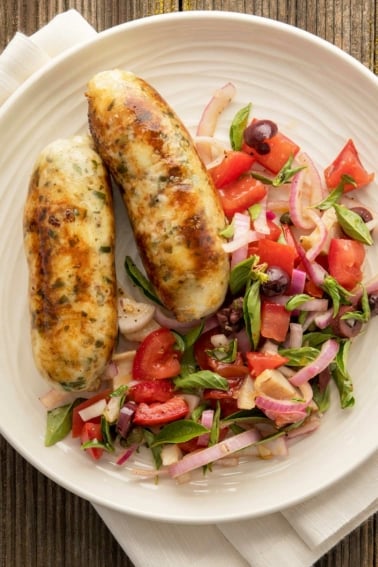As an Amazon Associate I earn from qualifying purchases.

Merguez sausage is the signature sausage of North Africa, especially Morocco and Tunisia. It is normally made with lamb (or mutton) and lamb fat, but in this case I am using venison; either works, and you can use beef or, untraditionally, pork.
Tunisian merguez sausages are spicy, almost exotic tasting. I’ve made merguez off and on for years, an was in fact featured in Food & Wine for my merguez back in 2010. This recipe is my latest rendition of that one.
Merguez hinges on harissa, a chile paste they use in North Africa that’s a combination of sweet and hot chiles, garlic, coriander, caraway, mashed with a little lemon and olive oil. I buy it in tubes imported from Tunisia. It’s easily available in supermarkets now.
Harissa is vital to the flavor here, and you can buy it in specialty shops, big supermarkets, you can buy harissa online, or you can make it yourself.
Interestingly, while merguez turns out bright red when uncooked, it loses a lot of that color when grilled. Oh, and if you are worried that these links will blow your head off with heat, think again. Yes, they are spicy, but it’s not really a hot spicy, just interesting.
Merguez is a grilling sausage, but I’ve fried them in clarified butter, and put them in braises and stews, too. They also make one helluva hot dog substitute!
One interesting trick would be to smoke them over oak or fruit wood, as cool and as slowly as you can to partially dry them out. Then hang in the fridge a few days before storing or serving. This makes them a little like kabanosy, my favorite meat stick.
New to making sausage? You can find my detailed tutorial on how to make sausages at home here.
Merguez Sausages
Ingredients
- 4 pounds venison
- 1/2 pound venison fat
- 1/2 pound pork fatback
- 34 grams kosher salt, about 3 rounded tablespoons
- 1 tablespoon minced garlic
- 1 tablespoon sweet paprika
- 2 teaspoons black pepper
- 2 teaspoons ground cumin
- 2 teaspoons ground coriander seed
- 1/4 cup harissa
- 2 tablespoons red wine vinegar
- 1/3 cup water
- Sheep casings
Instructions
- Get out about 20 feet of sheep casings and soak them in warm water. If you don’t trust your source, run water through them to check for punctures or weak spots.
- Make sure all your equipment is cold; freeze your grinder's grinding plate and blades, and the bowl you will put the meat into for 30 minutes to an hour. Do the same for the meat and fat. When everything’s nice and cold, mix the meat and fat with the salt and all the dry spices.
- Grind it all through a coarse plate; I use a 10 mm plate. Test the temperature of the mixture, and if it’s 35°F or colder, go ahead and grind it all again through a fine die, like a 4.5 mm or thereabouts. If it’s warmer, put the mix back in the freezer to chill until it hits 35°F or cooler.
- Once the sausage has been ground twice, test the temperature again to make sure it’s cold. I prefer to chill the mix down to 28°F to 32°F for this next stage. Chill the mix and when it’s cold enough, take it out and add the harissa, vinegar and water. Now, mix and knead the mixture in a big bin or bowl with your hands for a solid 2 minutes — your hands will ache with cold, which is good. You want everything to almost emulsify.
- Stuff the sausage into sheep casings rather loosely. It's pretty important that you have a narrow stuffing tube for your stuffer, or the sheep casings will break. I like my merguez to be about 6 to 8 inches long, but it’s your choice. To twist them into links, tie off one end of the coil you just made. Pinch off links with your two hands and roll the link between them forward a couple times. Move down the coil and repeat, only this time roll backwards a few times. Repeat until you do the whole coil. (This video shows how I do it.) Now look at the links, which will probably have air pockets in them. Use a sterile needle or sausage pricker (set it aglow in your stovetop flame) to puncture the casing over all the air pockets. Gently compress the links together to squeeze out the air pockets and rotate the links a bit more to tighten; this takes practice.
- Hang your links for at least 1 hour if your room is warm, and up to overnight if you can hang them in a place that’s 40°F or cooler. Don’t let them freeze yet. If you are not hanging overnight, let the sausages continue to dry uncovered in the fridge overnight before you seal them up and freeze. Merguez will keep a week in the fridge and a year in the freezer, if you have vacuum-sealed them.
Nutrition
Nutrition information is automatically calculated, so should only be used as an approximation.






Hello Hank.
Going to make these with duck and smoke them.
What meat temperature? What pit temperature?
Maybe I will run into you at Howard Slough sometime. I hunt there a bunch.
Thanks for all you do, Stan.
Stanley: I’d shoot for an internal temperature of about 150F. Keep the pit coolish, like under 200F.
Hank, would bear meat work for this sausage recipe? I don’t make a ton of sausage but this one in particular looks interesting to me, and right now all I have is bear meat as far as game meat goes.
Tony: Yes, but be sure to cook it all the way through. No rare bear sausage!
You created a great merguez. Only you could create a great Mazzafegati salati to win honors. Pork,1/3 liver,vinegar, garlic,cloves,allspice, coriander,hot flakes,etc. Best italian exotic sausage.
Hello and thanks for publishing such a great website and cook books. I have opportunity to harvest Aoudad and enjoy the meat just about any way I prepare it, but I have a thing for cooking meat in traditional local fashions. I will be trying this sausage recipe but I want to ask if you can point me in the direction of other recipes which would be traditional ways to prepare Aoudad in North Africa (or would have when they were more numerous). I intend to try your kebab recipe as well.
James: Yes, look up anything from Morocco, Tunisia, Algeria or Libya.
I made aoudad merguez a couple seasons back and that is now my go-to with aoudad meat. I’ve been playing around with the recipe a bit but you can’t go wrong with it. It makes an odd but great breakfast taco and pasta meat sauce replacement, too.
Hank, I found a stellar deal on the harissa you recommend. 4 tubes for $8 from World Market. Got them today and the best by date is from two months ago. What are your thoughts on the shelf life of harissa? Will it still be good? Also, I’ll only use one tube for this round of sausages. Will the other three keep in the freezer?
Thanks!
Hi Hank,
I am making Merguez with Venison meatloaf mix my butcher made for me last year… It has beef and pork fat added to the ground Venison form the Whitetail deer he cut up for me. I plan to leave it in bulk… The last batch I ground myself with pork butt and did half sheep casing links and half in bulk packages. My family loved when i formed it into patties for breakfast sausage. I had about 10 pounds of meatloaf mix left over so I am trying a batch with it. Should be way easier with no grinding and no stuffing this time. This batch will have beef fat and pork fat… I am optimistic about the results!
Doug
Hi.I’m fromwestern part of africa,so all the recipe seems strange to me but my love for sausage is crazy and my daughter too,I hope to make this for my family. But not sure I can find all the ingredients. E.g the fatty venison,vernison fat.can you please recomend a replacement
Thanks for this wonderful site.
Mrs. Coker: Use lamb or goat in place of venison.
Hank,
I ordered sheep casings using the link. I’m going to make this recipe (as well as the kabanosy recipe from Buck, Buck, Moose). I’ve never stuffed sausages before and have been doing some research but I’m getting conflicting answers (on the internet? no way!) Any idea about how many feet of sheep casings to make 5 lbs of sausage? Also can you please clarify which method of cooking (smoking vs poaching) you would recommend before re-freezing with this recipe? Thanks in advance for your help. And thanks a thousand times over for your awesome website and the most amazing venison cookbook ever.
Beth: I honestly can’t tell ya on the feet needed. I never really measure. Casings don’t go bad, so I buy in bulk and use as needed. As for pre-cooking before refreezing, I’d smoke the merguez. You’ll get a way better flavor when you ultimately heat-n-eat them.
Hank,
I am cleaning out the deep freeze in preparation for deer season and I’d like to make these using some venison from 2015. I know (from reading Buck, Buck, Moose) that I should not re-freeze uncooked meat so I am curious if you think I would be better off to smoke or poach them prior to freezing again. I appreciate your help and keep up the great work. Buck, Buck, Moose is outstanding and I’m so excited to try new recipes this year.
Beth: Yep, either cooking method will work.
Hank: Looking forward to trying this with 50% goose and 50% deer meat. Can you send me the link to the Harissa recipe mentioned in the earlier comments? Best regards,
Jonas
Hey Hank,
Thanks for the recipe. Made it with 80% elk (wild from Northern Alberta’s aspen woods) with 20% pork back fat. Made two modifications to satisfy our sausage tendencies. Per 5lbs, we added 2 tsp fennel seed (toasted then ground), 2 tsp white sugar and 50grams of skim milk powder. We just like a bit of sweet with the heat. Turned out beautifully.
Love your stuff, keep doing it!
Hank,
I tried this sausage with goat and home-made smoked bacon (as the fat). The harissa was DIY from the link you had provided. Wow. Fantastic. I first had merguez in Paris at a North African restaurant and fell in love with it. Thank You very much for posting this recipe!
Hank,
I worked really hard to find a good Merguez recipe. I never liked adding harissa only because every jar of harissa can be so different (and salty as hell!).
So I broke down the harissa into its ingredients and started over. I really like the result. My recipe packs a heavy punch–something like a really spicy chorizo (Mexican).
Try this formulation some time, I’d be interested to have your opinion!
4½# lamb
½# beef fat
30 *arbol chiles (seeded)
2½ tsp. *coriander seeds
2½ tsp. *cumin seeds
1¼ tsp. *black peppercorns
¼ c. fresh cilantro, minced
1¼ tsp. dry oregano
2½ tsp. chili powder
2½ tbs. garlic powder
5 tbs. paprika
3 tbs. onion powder
2 tbs. salt
2 tbs. buttermilk powder
2 c. plain bread crumbs
curing salt (1/4# per 100# meat)
The “*” get toasted in a dry pan and then put through a coffee grinder. Then proceed as with any fresh sausage.
On the patty issue, I would wrap the patties in caul fat to hold them together. Sort of a crepinette.
How would you modify the recipe to make patties, sans casing? I love merguez, but I’m not ready to commit to sausage making…
Thanks,
JD
Joss: Just make patties after you mix the meat and fat with the liquid ingredients.
What sausage stuffer do you recommend? We did about 50 lbs of antelope sausage this year with a kitchenaid mixer grinder attachment. It was a pain, but the sausages turned out good. Looking to upgrade for future sausage making projects. Thanks!
Kelli: I’ve been using the most basic 5-pound capacity stuffer from The Sausage Maker for over a decade, with no complaints!
Hank- looks like you squeeze out all the sausages first in a big coil then twist them off later, correct? Last time I tried that it didn’t work out to well and the casings broke, so I went back to twisting them off as they come out of the stuffer spout. But I was doing the large diameter spout w/hog casings. Please advise
Clif: Yep, that’s what I do. You were stuffing the casings too tight if they broke when twisting off. Leave them a little looser and you will be fine. It takes practice to know just how much.
Hank, this might be a foolish question: Have you ever experimented with using deer casings? I figure you might have because of your focus on using as much as the animal as possible. If not, you are getting pretty close by using caul fat.
Dom: I haven’t. Just a matter of will. Never wanted to rinse and clean the guts.
What a coincidence. I was pondering how to include venison in couscous about an hour ago and I come onto this site and, there it is, venison merguez. Great idea.
Delicious stuff! Just a note to those who haven’t used sheep casings before…they can be a bit of a pain to work with. Look at the size of the stuffing tube on Hank’s stuffer. If you don’t have one that small, take his advice and buy it before you try working with sheep casings. The smallest one that came with my LEM stuffer (11/16 outside diameter) is a little bigger than ideal. The one he linked to from the sausage maker is 1/2″ outside diameter, and that little bit makes a huge difference.
Use a snack stick stuffing tube with sheep casings. I think it’s a 3/8″ OD tube. The casings will be a bit loose but will thread onto the tube easier. I find it they thread more easily if I do it in the sink with a trickle of water running through the tube and casing. This inflates and unkinks it which makes loading the horn much easier.
Re. linking the sausages- search for “butcher’s braid” videos. Much easier than twisting the links individually.